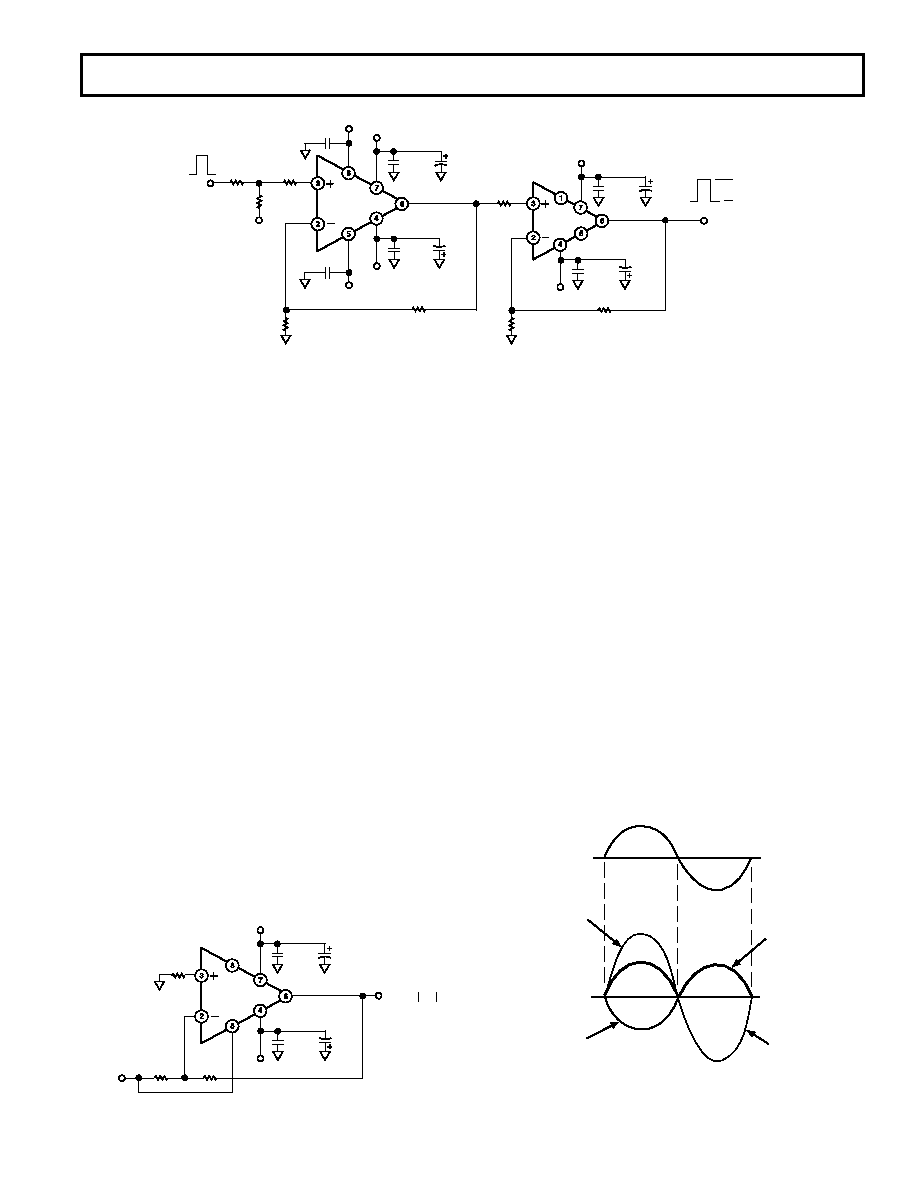- 您現在的位置:買賣IC網 > PDF目錄68798 > 5962-9559701MPX (ANALOG DEVICES INC) OP-AMP, CDIP8 PDF資料下載
參數資料
| 型號: | 5962-9559701MPX |
| 廠商: | ANALOG DEVICES INC |
| 元件分類: | 運算放大器 |
| 英文描述: | OP-AMP, CDIP8 |
| 封裝: | CERDIP-8 |
| 文件頁數: | 11/23頁 |
| 文件大小: | 437K |
| 代理商: | 5962-9559701MPX |

AD8036/AD8037
REV. B
–19–
The circuit uses an AD8037 operating at a gain of two with an
AD811 to boost the output to the
±12 V range. The AD811 was
chosen for its ability to operate with
±15 V supplies and its high
slew rate.
R1 and R2 act as a level shifter to make the TTL signal levels be
approximately symmetrical above and below ground. This ensures
that both the high and low logic levels will be clamped by the
AD8037. For well controlled signal levels in the output pulse,
the high and low output levels should result from the clamping
action of the AD8037 and not be controlled by either the high
or low logic levels passing through a linear amplifier. For good
rise and fall times at the output pulse, a logic family with high
speed edges should be used.
The high logic levels are clamped at two times the voltage at VH,
while the low logic levels are clamped at two times the voltage
at VL. The output of the AD8037 is amplified by the AD811
operating at a gain of 5. The overall gain of 10 will cause the
high output level to be 10 times the voltage at VH, and the low
output level to be 10 times the voltage at VL.
High Speed, Full-Wave Rectifier
The clamping inputs are additional inputs to the input stage of
the op amp. As such they have an input bandwidth comparable
to the amplifier inputs and lend themselves to some unique
functions when they are driven dynamically.
Figure 12 is a schematic for a full-wave rectifier, sometimes
called an absolute value generator. It works well up to 20 MHz
and can operate at significantly higher frequencies with some
degradation in performance. The distortion performance is sig-
nificantly better than diode based full-wave rectifiers, especially
at high frequencies.
VOUT = VIN
+5V
RF
274
–5V
100
VH
VL
VIN
0.1 F10 F
AD8037
0.1 F
10 F
RG
274
Figure 12. Full-Wave Rectifier
TTLIN
+15V
PULSE
OUT
VH
10
VL
10
–15V
+5V
274
–5V
100
VH
VL
0.1 F
10 F
0.1 F
AD8037
0.1 F10 F
VH
0.1 F
VL
274
1.3k
200
100
AD811
–15V
0.1 F10 F
0.1 F
10 F
604
150
Figure 11. Programmable Pulse Generator
The circuit is configured as an inverting amplifier with a gain
of one. The input drives the inverting amplifier and also directly
drives VL, the lower level clamping input. The high level clamp-
ing input, VH, is left floating and plays no role in this circuit.
When the input is negative, the amplifier acts as a regular unity-
gain inverting amplifier and outputs a positive signal at the same
amplitude as the input with opposite polarity. VL is driven nega-
tive by the input, so it performs no clamping action, because the
positive output signal is always higher than the negative level
driving VL.
When the input is positive, the output result is the sum of two
separate effects. First, the inverting amplifier multiplies the input
by –1 because of its unity-gain inverting configuration. This
effectively produces an offset as explained above, but with a
dynamic level that is equal to –1 times the input.
Second, although the positive input is grounded (through 100
),
the output is clamped at two times the voltage applied to VL (a
positive, dynamic voltage in this case). The factor of two is
because the noise gain of the amplifier is two.
The sum of these two actions results in an output that is equal
to unity times the input signal for positive input signals, see Fig-
ure 13. For a input/output scope photo with an input signal of
20 MHz and amplitude
±1 V, see Figure 14.
INPUT
FULL WAVE
RECTIFIED
OUTPUT
LOWER
CLAMPING
LEVEL WITH
NO NEG INPUT
OUTPUT
LOWER
CLAMPING
LEVEL
–1
INPUT
Figure 13.
相關PDF資料 |
PDF描述 |
|---|---|
| 5962-9559801MRX | LOG OR ANTILOG AMPLIFIER, 250 MHz BAND WIDTH, CDIP20 |
| 5962-9560301QPA | DUAL OP-AMP, 500 uV OFFSET-MAX, 0.06 MHz BAND WIDTH, CDIP8 |
| 5962-9564001NXD | DUAL OP-AMP, 1500 uV OFFSET-MAX, PDSO8 |
| 5962-9564001Q2A | DUAL OP-AMP, 1750000 uV OFFSET-MAX, 0.21 MHz BAND WIDTH, CQCC20 |
| 5962-9564001QHA | DUAL OP-AMP, 1750000 uV OFFSET-MAX, 0.21 MHz BAND WIDTH, CDFP10 |
相關代理商/技術參數 |
參數描述 |
|---|---|
| 5962-9559801MRA | 功能描述:對數放大器 DESC 250MHZ DEMODULATING LOGAMP RoHS:否 制造商:Texas Instruments 通道數量:3 帶寬:3 dB 共模抑制比(最小值): 輸入補償電壓:+/- 7 mV 輸入電壓范圍(最大值):5.5 V 工作電源電壓:4.5 V to 5.5 V 電源電流:+/- 15 mA 工作溫度范圍:- 40 C to +85 C 安裝風格:SMD/SMT 封裝 / 箱體:VQFN-16 封裝:Reel |
| 5962-9560001M9A | 制造商:White Electronic Designs 功能描述:512K X 8 SRAM MONOLITHIC, 5V, 45NS, 32 FLATPACK, TINNED LEAD - Bulk |
| 5962-9560001MMA | 制造商:Micross Components, Inc. 功能描述:SRAM, 4MB - Trays 制造商:White Electronic Designs 功能描述:512K X 8 SRAM MONOLITHIC, 5V, 45NS, 36 CSOJ, TINNED LEADS, S - Bulk |
| 5962-9560001MTA | 制造商:White Electronic Designs 功能描述:512K X 8 SRAM MONOLITHIC, 5V, 45NS, 36 FLATPACK, TINNED LEAD - Bulk |
| 5962-9560001MUA | 制造商:White Electronic Designs 功能描述:512K X 8 SRAM MONOLITHIC, 5V, 45NS, 32 CSOJ, TINNED LEADS, S - Bulk |
發(fā)布緊急采購,3分鐘左右您將得到回復。